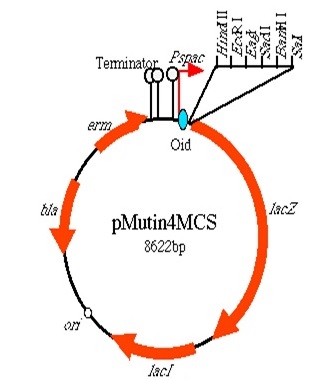Team:Newcastle/Parts/HBsu-fp
From 2013.igem.org
| Line 21: | Line 21: | ||
The second version of the BioBrick have RFP (BBa_E1010) conjugated to the HBsu. | The second version of the BioBrick have RFP (BBa_E1010) conjugated to the HBsu. | ||
[[Image:BareCillus_HBSu-RFP.png|frameless|700px]] | [[Image:BareCillus_HBSu-RFP.png|frameless|700px]] | ||
| + | |||
| + | These BioBricks code for a HBsu protein attached to a superfolded green fluorescent protein (sfGFP). HBsu is a non-specific DNA binding protein that binds to DNA as a homodimer. The HBsu is joined to the sfGFP through ten amino acid flexible linker sequence. This allows the observation of Bacillus subtilis DNA using fluorescence microscopy. The integration strategy that we opted for was to clone in the BioBrick into the Multiple cloning site of pMutin4 backbone. First we attached HindIII restriction sites on 5'end and SacII restriction sites on 3'end of the BioBrick. We then cut the pMutin4 backbone and BioBrick using the previously mentioned restriction enzymes, this allowed us to ligate the plasmid and BioBrick together. We also attached a ~300bp amyE homology region onto the 3'end of the BioBrick after the SacII to allow the single cross over and integration of the whole plasmid into the genome. The pMutin4 plasmid contains a ery+ resistance marker for B.subtilis and amp+ for E.coli and also contains lacI, lacZ and Pspac promoter which is an IPTG induced promoter which regulated the transcription of this BioBrick. An alternative method to use this part would be to clone this BioBrick out and use any Assembly protocol to attach a desired promoter, RBS and antibiotic resistance genes. | ||
==Integration== | ==Integration== | ||
Revision as of 14:04, 19 September 2013

Contents |
HBsu-xFP Fusion
Purpose and Justification
Bacillus subtilis contains HBsu, a non-specific DNA binding protein which is a homologue to eukaryotic histones. This protein is encoded by the gene hbs gene which is 263bp in length and involved not only in DNA binding but also SRP, DNA repair, HR, and pre-secretory protein translocation [http://www.ncbi.nlm.nih.gov/pubmed/10224127 (Kouji, et al., 1999)]. It binds to DNA by forming homodimer.
We conjugated the hbs gene with red fluorescent protein (RFP/GFP) in order to fluorescently tag the bacterial chromosome. We produced [http://parts.igem.org/Part:BBa_K1185001 BBa_K1185001] which codes for a HBsu-sfGFP conjugate and [http://parts.igem.org/Part:BBa_K1185002 BBa_K1185002] coding for a HBsu-RFP conjugate. Each bacterium was transformed with only one or the other. The expression of these BioBricks was regulated through an IPTG induce promoter (Pspac).
We fused one bacteria containing HBsu-RFP and another containing HBsu-sfGFP, and viewed the genomic shuffling via fluorescent microscopy. The formation of a colour mosaic allows us to confidently claim that recombination has occurred. Genomic shuffling has importance as it can be used to evolve and improve a cells phenotype.
Assembly
HBsu-(x)FP
BioBrick encodes a fusion protein HBsu-(x)FP protein by 10 amino acids flexible linker (BBa_K105012).
The first version of the BioBrick have superfolder GFP (BBa_E0040)conjugated to the HBsu.

The second version of the BioBrick have RFP (BBa_E1010) conjugated to the HBsu.

These BioBricks code for a HBsu protein attached to a superfolded green fluorescent protein (sfGFP). HBsu is a non-specific DNA binding protein that binds to DNA as a homodimer. The HBsu is joined to the sfGFP through ten amino acid flexible linker sequence. This allows the observation of Bacillus subtilis DNA using fluorescence microscopy. The integration strategy that we opted for was to clone in the BioBrick into the Multiple cloning site of pMutin4 backbone. First we attached HindIII restriction sites on 5'end and SacII restriction sites on 3'end of the BioBrick. We then cut the pMutin4 backbone and BioBrick using the previously mentioned restriction enzymes, this allowed us to ligate the plasmid and BioBrick together. We also attached a ~300bp amyE homology region onto the 3'end of the BioBrick after the SacII to allow the single cross over and integration of the whole plasmid into the genome. The pMutin4 plasmid contains a ery+ resistance marker for B.subtilis and amp+ for E.coli and also contains lacI, lacZ and Pspac promoter which is an IPTG induced promoter which regulated the transcription of this BioBrick. An alternative method to use this part would be to clone this BioBrick out and use any Assembly protocol to attach a desired promoter, RBS and antibiotic resistance genes.
Integration
Testing and Characterisation
References
[http://www.ncbi.nlm.nih.gov/pubmed/10224127 Kouji, N., Shou-ichi, Y., Takao, Y. & Kunio , Y., 1999. Bacillus subtilis Histone-like Protein, HBsu, Is an Integral Component of a SRP-like Particle That Can Bind the Alu Domain of Small Cytoplasmic RNA. The Journal of Biological Chemistry , Volume 274, pp. 13569-13576.]
 "
"

